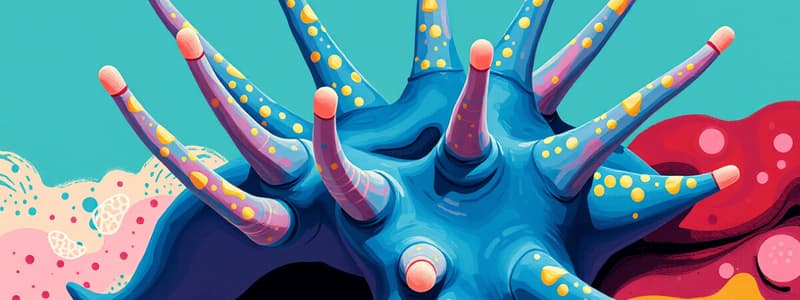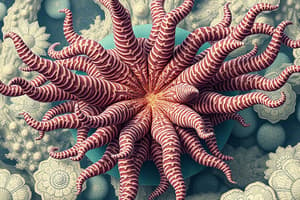Podcast
Questions and Answers
Which of the following are characteristics of Echinodermata? (Select all that apply)
Which of the following are characteristics of Echinodermata? (Select all that apply)
- Radially symmetrical adult bodies (correct)
- Freshwater species
- Five part body plan (correct)
- Deuterostomes (correct)
What are ossicles?
What are ossicles?
Calcareous plates that make up an Echinoderm's internal skeleton.
Who is in the phylum Echinodermata?
Who is in the phylum Echinodermata?
Sea stars, sea urchins, sand dollars, and sea cucumbers.
What does the word Echinoderm mean?
What does the word Echinoderm mean?
How are the five classes of Echinoderms primarily distinguished?
How are the five classes of Echinoderms primarily distinguished?
What are dermal gills?
What are dermal gills?
What are pedicellariae?
What are pedicellariae?
What is a madreporite?
What is a madreporite?
What is an ambulacral groove?
What is an ambulacral groove?
What is an ambulacral ridge?
What is an ambulacral ridge?
What organisms belong to class Asteroidea?
What organisms belong to class Asteroidea?
What are the characteristics of spines in class Asteroidea?
What are the characteristics of spines in class Asteroidea?
What can you see in the oral view of a sea star?
What can you see in the oral view of a sea star?
What can you see in the aboral view of a sea star?
What can you see in the aboral view of a sea star?
What type of symmetry does the bipinnaria larval stage of a starfish demonstrate?
What type of symmetry does the bipinnaria larval stage of a starfish demonstrate?
Who is in class Ophiuroidea?
Who is in class Ophiuroidea?
Who is in class Crinoidea?
Who is in class Crinoidea?
Who is in class Echinoidea?
Who is in class Echinoidea?
What is a test?
What is a test?
What is Aristotle's lantern?
What is Aristotle's lantern?
Is the sea urchin's test pentaradially symmetrical?
Is the sea urchin's test pentaradially symmetrical?
What does pentaradially symmetrical mean?
What does pentaradially symmetrical mean?
Who is in class Holothuroidea?
Who is in class Holothuroidea?
What is evisceration in sea cucumbers?
What is evisceration in sea cucumbers?
What do some sea cucumbers do in response to stress?
What do some sea cucumbers do in response to stress?
What is the water vascular system?
What is the water vascular system?
Flashcards
Deuterostome
Deuterostome
An animal whose embryonic development involves the formation of the anus first, before the mouth.
Radial Symmetry
Radial Symmetry
Body parts radiate out from a central point.
Calcareous Ossicles
Calcareous Ossicles
Tiny, hard, calcium-containing plates that form the internal skeleton of echinoderms.
Water Vascular System
Water Vascular System
Signup and view all the flashcards
Regeneration
Regeneration
Signup and view all the flashcards
Marine
Marine
Signup and view all the flashcards
Tube Feet
Tube Feet
Signup and view all the flashcards
Echinoderm
Echinoderm
Signup and view all the flashcards
Ossicles (structure)
Ossicles (structure)
Signup and view all the flashcards
Sea Star
Sea Star
Signup and view all the flashcards
Sea Urchin
Sea Urchin
Signup and view all the flashcards
Sand Dollar
Sand Dollar
Signup and view all the flashcards
Sea Cucumber
Sea Cucumber
Signup and view all the flashcards
Aristotle's Lantern
Aristotle's Lantern
Signup and view all the flashcards
Dermal Gills
Dermal Gills
Signup and view all the flashcards
Pedicellariae
Pedicellariae
Signup and view all the flashcards
Madreporite
Madreporite
Signup and view all the flashcards
Ambulacral Groove
Ambulacral Groove
Signup and view all the flashcards
Ambulacral Ridge
Ambulacral Ridge
Signup and view all the flashcards
Evisceration
Evisceration
Signup and view all the flashcards
Bilateral Symmetry
Bilateral Symmetry
Signup and view all the flashcards
Pentaradial Symmetry
Pentaradial Symmetry
Signup and view all the flashcards
Study Notes
Characteristics of Echinodermata
- Echinoderms are classified as deuterostomes, exhibiting unique developmental patterns.
- Adults feature radial symmetry, with a five-part body plan.
- Internal skeletons are composed of calcareous ossicles.
- A water vascular system facilitates movement through tube feet.
- Notable for regeneration abilities, all members are exclusively marine.
Ossicles
- Ossicles are calcareous plates forming the internal skeleton of echinoderms, providing structural support.
Phylum Members
- Common members of Echinodermata include sea stars, sea urchins, sand dollars, and sea cucumbers.
Etymology
- The term "Echinoderm" derives from Greek, with "echino" meaning spiny and "derm" meaning skin.
Classification of Echinoderms
- The five classes of echinoderms are distinguished by the arrangement of their ossicles.
Dermal Gills
- Dermal gills are small projections that assist in respiration and excretion through diffusion.
Pedicellariae
- Tiny pincers called pedicellariae maintain the body surface cleanliness by removing debris.
Madreporite
- The madreporite is an opening that filters water into the echinoderms' water vascular system.
Ambulacral Structures
- An ambulacral groove is a channel on the oral side where tube feet extend.
- The ambulacral ridge lies at the top of the groove, harboring the radial canals.
Class Specifics
- Class Asteroidea includes sea stars, characterized by small, blunt spines.
- In oral view, sea stars display tube feet, arms, spines, mouth, and ambulacral groove.
- Aboral view shows arms, anus, spines, central disk, and madreporite.
Larval Symmetry
- The bipinnaria larval stage of sea stars exhibits bilateral symmetry.
Other Classes
- Class Ophiuroidea consists of brittle stars.
- Class Crinoidea includes sea lilies and feather stars.
- Class Echinoidea comprises sea urchins and sand dollars.
- The test in echinoids is a solid structure formed by fused ossicles.
Noteworthy Structures
- Aristotle's lantern refers to sea urchins' oral apparatus for grazing; it consists of five ossified plates.
- The sea urchin's test exhibits pentaradial symmetry characteristic of adult echinoderms.
Class Holothuroidea
- Sea cucumbers belong to this class and have unique adaptations.
Evisceration
- Evisceration is a defense mechanism in sea cucumbers involving the forceful expulsion of internal organs.
Water Vascular System
- This system comprises canals filled with a watery fluid, enabling tentacle and tube foot movement.
Studying That Suits You
Use AI to generate personalized quizzes and flashcards to suit your learning preferences.




